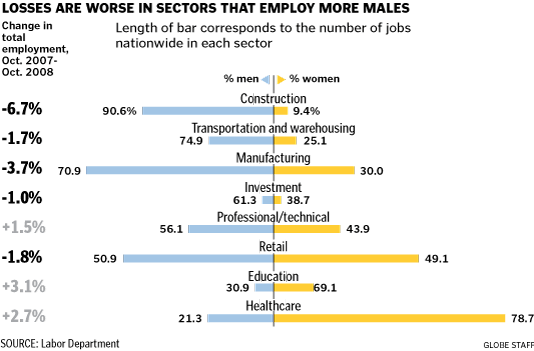The Boston Globe didn’t put a fine tip on Thursday’s BLS report (PDF).
1,069,000 fewer men are working than a year ago. 12,000 more women are working.
Here’s their chart:

Many economists have picked up on the dismal news about unemployment, but the only one really talking about the gender disparity is Mark Perry, but he hasn’t really gone into depth about why this statistic is the way it is, besides the obvious: more men work in industries that were harder hit than women. This is obvious, and it can be clearly seen in the chart from the Globe above.
My mom had an interesting take on this employment news. Her first reaction was, “Well I’m not surprised. Men make more than women, so it makes more sense that they’d let men go before women.” There’s a substantial amount of data to back this up. The most recent numbers that I’ve seen have women earning 77 cents for every dollar a man earns, on average. Therefore laying a man off has more of an impact on the bottom line than laying a woman off.
The other thing to consider is the rates of attendance in college for men. While there are certainly holdouts in academia that are dominated by men, overall attendance in college has already tipped in favor of women, and it’s expected to reach 60/40 female/male ratio by 2009. This trend shows no signs of reversing, and frankly it’s got me worried.
I don’t think education is, or should be treated as, a zero-sum game. Women don’t have to “win” at the expense of men, and vice versa. There are no winners and losers in education — it’s one of those things where all of society benefits the more it has. (We call these positive externalities, which is why we subsidize institutions and projects that have them with public money.)
In 1960, what I’ll call “affirmative action” for women began, and there were 1.6 males for every female graduating from college. In 2003, that ratio was 1.35 females for every male. In 2006, women made up 58% of undergraduates, and this trend is increasing. Men simply don’t apply to college in the numbers that women do. A widely disseminated article in the NYTimes, written by an admissions officer illustrates the point nicely:
Few of us sitting around the table were as talented and as directed at age 17 as this young woman. Unfortunately, her test scores and grade point average placed her in the middle of our pool. We had to have a debate before we decided to swallow the middling scores and write “admit” next to her name.
Had she been a male applicant, there would have been little, if any, hesitation to admit. The reality is that because young men are rarer, they’re more valued applicants. Today, two-thirds of colleges and universities report that they get more female than male applicants, and more than 56 percent of undergraduates nationwide are women. Demographers predict that by 2009, only 42 percent of all baccalaureate degrees awarded in the United States will be given to men.
We have told today’s young women that the world is their oyster; the problem is, so many of them believed us that the standards for admission to today’s most selective colleges are stiffer for women than men. How’s that for an unintended consequence of the women’s liberation movement?
I don’t have an answer about what, if anything, should be done about this trend. I do believe that the educational system is failing the male sex in this country, and it’s going to be a while before this trend is reversed simply because of the lag effect. I think society has forgotten about the boys while placing most of the focus on improving girls’ performance in school.
Moreover, I think these employment numbers may be the first reflections of this trend. By and large, there aren’t many well-paying jobs for women that do not require a college education. Men can fairly easily make money doing physical labor — which tends to pay well — than can women. Consequently, a college education may be less desirable for a man contemplating post-high-school job options. I don’t know; it’s been quite a while since I was in high school, and not going to college was never an option.
Of course the downside to this is that recessions that hit construction and other similar industries disproportionally affect men. In this particular instance, I would expect that these numbers will not look so bad in another 12 months, if for no other reason that Obama is planning some serious stimulus to be spent by state governments on infrastructure projects which will likely put these laborers back to work. This was announced in his most recent weekly address, which I’ve embedded (now in HD!) below:
Even without the investment in infrastructure, I would expect the disparity to decrease somewhat as the recession settles in and unemployment and overall employee churn stabilize.
Thanks for this. http://rianjs.net/ is now in my feed reader, I’ll keep and eye out for your next story. I like the layout of your site, nice and clean and easy to read. Thakns.
Hi. Your site displays incorrectly in Opera, but content excellent! Thank you for your wise words:)